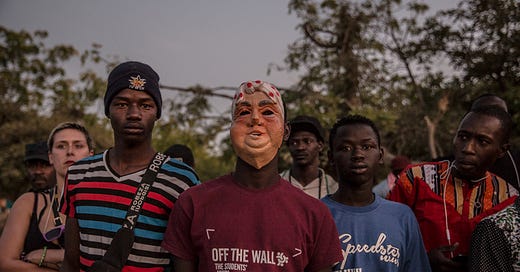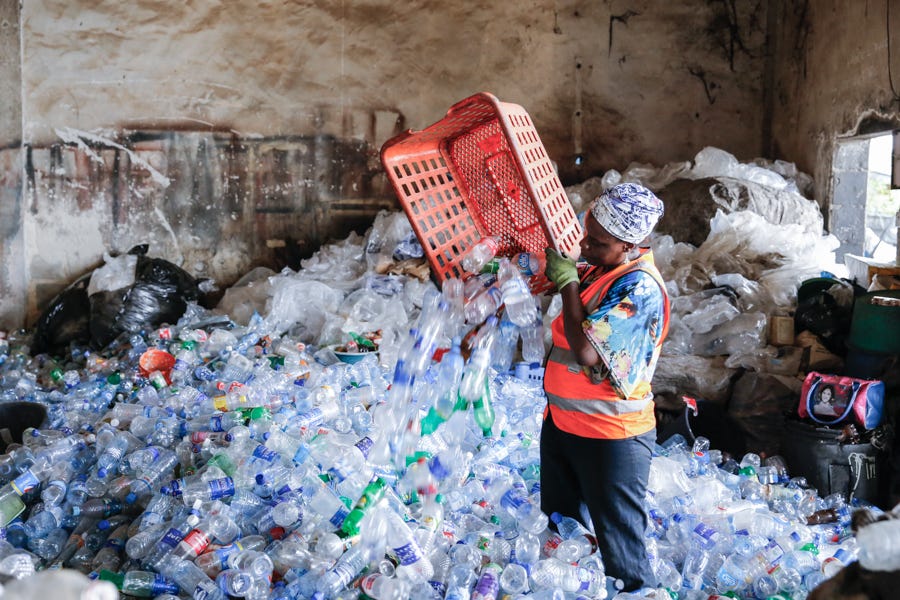A photograph taken in low light. The three young men, flanked by two others dissimilar in comportment, direct their gaze at anyone who directs a gaze at them. One with a bag slung over his shoulder, another wearing an off the wall t-shirt, the third baby-faced yet unflinching. The second, you could also say, is at the centre of it all, accorded prominence by his face, or the plastic mask he’s chosen as a prop. And two others who flank the three young men: a woman as stand-out in the intensity of her gawk as in the contrast of her skin (notice the sunglasses tucked over the sling of her bag). Another young man, whose palm cradles a phone, his attention pulled away from it, pictured in the fraction of time it takes for a kind of rapture. Here’s a quadratic equation of spectacle: performer, one who watches a performance, one who is seen watching a performance, and one who sees a record of those seen watching a performance.
Nyancho NwaNri: “The most important part of photography for me is human connection.”
This photograph was taken at the Kankurang Festival in Janjangbureh, Gambia, 2019.
While out and about in Banjul, the capital, I saw a flyer posted on the fence of the National Museum advertising the Kangkurang Festival, an annual festival founded with the mission to promote and preserve Gambia’s masquerade culture. It was just 4 days to the festival (which was happening on the opposite end of the country), but I went home, packed my bags and 3 days later was on a 5-hour bus ride to Janjangbureh.
I especially love the way this image mirrors the layering and connecting of dots that life entails. It brings another level of thought to the general context of the image. A masked man in a communal celebration of traditional masked figures; the mask that watches the masks.
For me, it was interesting to realise the possible connection between this plastic modern mask and the traditional masks on display, to ponder questions about how this ancient practice might have informed the use of masks in modern times, and the power a mask has to instantly enable the wearer embody an entirely different persona or identity, to switch between worlds at will.
In the moment while creating this photograph, I found myself wondering why this young man showed up to a masquerade performance in a mask. Was he merely trying to mimick the situation? Was it a way for him to feel more like a part of the festival? To embody the tradition of masquerades and masked dances? Or perhaps he just thought it cool? Whichever way, I couldn’t escape the thoughts and ideas that this sight conjured up in my mind.
The most important part of photography for me is human connection—seeing and meeting the people I photograph as human beings and not just subjects. So, when I approach a body of work, an assignment or a topic—for instance, Flooding in Lagos State—in that moment, I’m not just photographing some individual whose home has been flooded. I am photographing Kunle, a businessman and father of a two year old son who has made the painful decision to abandon his family home which he inherited from his father so that his son doesn’t have to grow up in a house that is constantly affected by flooding. What connects me to the people and places that I photograph and what connections can be drawn between the images I create and the people viewing them? What are the threads that bind us all in this particular moment? How can I photograph people in the most dignifying way possible even when the situation itself may not be ideal? These questions guide my documentary photography practice.
Photography has the power to shape our views and inform what we perceive to be reality. Stories told verbally and orally can indeed be very impactful but sight has a way of anchoring thoughts, perceptions and feelings in a lasting way.
At the height of the pandemic, during the lockdown, I took a walk around my neighbourhood and got into a discussion with some of the guys in the area about the Coronavirus. Of course, it was an exchange about whether it did truly exist or not, whether the entire pandemic was a hoax. One of the young men said to me, “If it is real and so many people are dying, why haven’t we seen pictures of those who have died?” They could not believe the things they had heard without seeing. However, it is this intrinsic power of an image that calls to mind the impact photography has as well as the considerations that must be taken by photographers, editors, publications and every cog in the wheel to ensure that photography is used as a tool of truth and does not skew or misconstrue the reality of the situation or context in which the images were created, as has often been the case in the history of the medium.
Two other photographs by Nyancho NwaNri
For each week’s feature, I send 3 photographs to the photographer, and ask them to respond to one. Here are the 2 other photographs I selected from Nyancho’s portfolio and sent to her. What do you think about any of them? You can respond as a comment below.
What to Watch
Last year, Everyday Projects presented Season 2 of their webinars for photographers and visual journalists across the globe (each video is 75-90 minutes). “These free, weekly workshops are for emerging and experienced editorial photographers who would like to learn more about the ins and outs of professional photojournalism.”
Thank you for reading and sharing this feature on Nyancho NwaNri. You can see more of her work on her website, LensCulture, and Instagram.
Every week I feature one photograph and the photographer who took it. You’ll read a short narrative caption from me, and a statement from the photographer. My goal is to set up conversations with the work of early to mid-career African photographers. You can support the newsletter by asking someone—or 10 people!—to subscribe.







